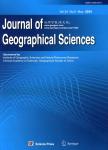Peat record of climate change for the last 3000 years in Yangmu, Mishan region of Sanjiang Plain
Peat record of climate change for the last 3000 years in Yangmu, Mishan region of Sanjiang Plain出 版 物:《Journal of Geographical Sciences》 (地理学报(英文版))
年 卷 期:2001年第11卷第4期
页 面:74-80页
核心收录:
学科分类:07[理学] 070601[理学-气象学] 0706[理学-大气科学]
基 金:National Natural Science Foundation of China No.49571073
主 题:peat record sporo-pollen analysis climate analysis Mishan region
摘 要:Five pollen zones are identified in Yangmu peatland of Mishan region located at 45o34扤, 132o23扙 through sporo-pollen analysis. The changing process of paleovegetation and paleoclimate was obtained. Warm-inclined broad-leaved forest predominated in the environment of warm climate with a little dry 3400 yr BP. Deciduous broad-leaved and coniferous mixed forests predominated, in which Pinus, Picea and Abies were main species, together with wet meadow in the environment of cool and humid climate during 3400-1940 yr BP. Deciduous broad-leaved and coniferous mixed forests predominated in the dry and warm climate environment 1940-1090 yr BP. Broad-leaved forest was predominant, and the climate was warm and humid 1090-545 yr BP. Marsh meadow predominated when the climate changed to cool and dry 545 yr BP. The composition of the upper part of the 143-125 cm of the peat profile presented the cold period in the early Christian era through mutual identification between the records of historical material such as spores and pollens, susceptibility, organic matter and archaeological studies. The composition of the parts of 125-85 cm and 85-38 cm presented the warm climate in the Northern and Southern Dynasty and Sui and Tang dynasties. Since 3400 yr BP because of the frequent human activities in Mishan region, the amount of cultural relics in the Sui and Tang dynasties increased, which indicated that the ancients took much more woods from the forests in the warm climate environment.



